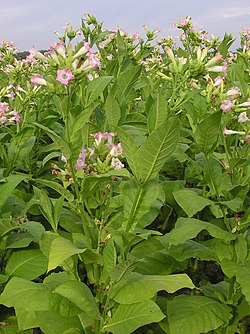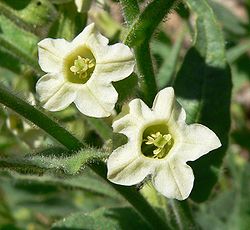Nome comune: tabacco
Specie: Nicotiana ssp. L.
Famiglia: SOLANACEAE
La Nicotiana tabacum e la Nicotiana rustica, coltivate in varie forme, sono piante erbacee a foglie molli, vellutato-glandolose, la Nicotiana glauca è invece specie legnosa, almeno inferiormente, con foglie rigide, glabre, lungamente picciolate.
I fiori di questo genere sono tubolosi, con corolla gialla nella Nicotiana glauca, giallo-verdognola nella Nicotiana rustica, rosa o rossiccia nella Nicotiana tabacum, bianca, con fiori ammucchiati in corimbi alla sommità del fusto fiorale, profumati e aperti solo di giorno nella Nicotiana sylvestris, verde-porpora all’esterno e bianca all’interno, a forma di piattino, alla sommità, nella Nicotiana noctiflora, che, tra l’altro, come suggerisce il nome specifico si apre solo di notte.
Nicotiana tabacum, che si trova solo in coltivazione, è la più conosciuta e certamente la più coltivata tra tutte le specie del genere Nicotiana; è coltivata principalmente per ottenere il tabacco, materiale per sigarette e sigari.
Tossicità
Tutte le piante di questo genere, da quelle ornamentali a quelle coltivate per la produzione del tabacco, contengono numerosi alcaloidi estremamente tossici, tra cui ricordiamo la nicotina: 40-50 mg di questo alcaloide provocano la morte di un adulto.
L’ingestione di foglie di tabacco provoca problemi al sistema nervoso, respiratorio e cardio-circolatorio.
L’uso del succo di tabacco come insetticida può rivelarsi molto pericoloso.
I danni del fumo, infine, sono ormai conosciuti da tutti e la letteratura medica non lascia dubbi al riguardo!
Curiosità
Questo genere è originario delle Americhe.
Il nome del genere, Nicotiana, è dedicato al diplomatico francese Jean Nicot, vissuto nel XVI secolo.
Seppure pianta non spontanea ma coltivata, la riportiamo nella sezione delle schede monotematiche per la diffusione della coltivazione anche nella nostra valle.
Galleria
Contents
Nicotiana
| Nicotiana | |
|---|---|

| |
| Nicotiana tabacum | |
| Scientific classification | |
| Kingdom: | Plantae |
| Clade: | Tracheophytes |
| Clade: | Angiosperms |
| Clade: | Eudicots |
| Clade: | Asterids |
| Order: | Solanales |
| Family: | Solanaceae |
| Tribe: | Nicotianeae |
| Genus: | Nicotiana L. |
| Type species | |
| Nicotiana tabacum L.
| |
| Species | |
|
See text | |
| Synonyms[1] | |
| |
Nicotiana (/ˌnɪkoʊʃiˈeɪnə, nɪˌkoʊ-, -kɒti-, -ˈɑːnə, -ˈænə/[2][3][4]) is a genus of herbaceous plants and shrubs in the family Solanaceae, that is indigenous to the Americas, Australia, Southwestern Africa and the South Pacific. Various Nicotiana species, commonly referred to as tobacco plants, are cultivated as ornamental garden plants. N. tabacum is grown worldwide for the cultivation of tobacco leaves used for manufacturing and producing tobacco products, including cigars, cigarillos, cigarettes, chewing tobacco, dipping tobacco, snuff, and snus.
Taxonomy
Species

The 79 accepted and known species include:[1][5][6]
- Nicotiana acuminata (Graham) Hook. – manyflower tobacco or many-flowered tobacco[7]
- Nicotiana africana Merxm.[7]
- Nicotiana alata Link & Otto – jasmine tobacco, sweet tobacco, winged tobacco, Persian tobacco, tanbaku (in Persian)[7]
- Nicotiana attenuata Torrey ex S. Watson – coyote tobacco[7]
- Nicotiana benthamiana Domin[7] – benth, benthi
- Nicotiana clevelandii A. Gray[7] – Cleveland's tobacco
- Nicotiana glauca Graham – tree tobacco, Brazilian tree tobacco, shrub tobacco, wild tobacco, tobacco plant, tobacco bush, tobacco tree, mustard tree[7]
- Nicotiana glutinosa L.
- Nicotiana langsdorffii Weinm.[7] – Langsdorff's tobacco
- Nicotiana longiflora Cav.[7] – longflower tobacco or long-flowered tobacco
- Nicotiana mutabilis Stehmann & Semir[1] – colour-changing tobacco plant, flowering tobacco plant
- Nicotiana occidentalis H.-M. Wheeler[7] – native tobacco
- Nicotiana obtusifolia M. Martens & Galeotti – desert tobacco, punche, "tabaquillo"[7]
- Nicotiana otophora Griseb.[7]
- Nicotiana plumbaginifolia Viv. – Tex-Mex tobacco
- Nicotiana quadrivalvis Pursh – Indian tobacco
- Nicotiana rustica L. – Aztec tobacco, strong tobacco, mapacho[7]
- Nicotiana suaveolens Lehm. – Australian tobacco[7]
- Nicotiana sylvestris Speg. & Comes – woodland tobacco, flowering tobacco, South American tobacco[7]
- Nicotiana tabacum L. – common tobacco, domesticated tobacco, cultivated tobacco, commercial tobacco (grown for the production of cigars, cigarillos, cigarettes, chewing tobacco, dipping tobacco, snuff, snus, etc.)[7]
- Nicotiana tomentosiformis Goodsp.[7]
Manmade hybrids
- – N. forsteri × N. tabacum[8]
- – N. glutinosa × N. tabacum[9]
- Nicotiana × sanderae Hort. ex Wats. – N. alata × N. forgetiana[8]
Formerly placed here
- Petunia axillaris (Lam.) Britton et al. (as N. axillaris Lam.) – large white petunia, wild white petunia, white moon petunia[10]
Etymology
The genus Nicotiana (from which the word nicotine is derived) was named in honor of Jean Nicot, French ambassador to Portugal, who in 1559 sent samples as a medicine to the court of Catherine de' Medici.[11]
Ecology


Despite containing enough nicotine and/or other compounds such as germacrene and anabasine and other piperidine alkaloids (varying between species) to deter most herbivores,[12] a number of such animals have evolved the ability to feed on Nicotiana species without being harmed. Nonetheless, tobacco is unpalatable to many species and therefore some tobacco plants (mainly tree tobacco (N. glauca)) have become established as invasive species in some places.[13]
In the 19th century, young tobacco plantings came under increasing attack from flea beetles (particularly the potato flea beetle (Epitrix cucumeris) and/or ), causing the destruction of half the United States tobacco crop in 1876. In the years afterward, many experiments were attempted and discussed to control the potato flea beetle. By 1880, it was discovered that covering young plants with a frame covered with thin fabric (instead of with branches, as had previously been used for frost control) would effectively protect the plants from the beetle. This practice spread until it became ubiquitous in the 1890s.[citation needed]
Tobacco, alongside its related products, can be infested by parasites such as the tobacco beetle (Lasioderma serricorne) and the tobacco moth (Ephestia elutella), which are the most widespread and damaging pests in the tobacco industry.[14] Infestation can range from the tobacco cultivated in the fields to the leaves used for manufacturing cigars, cigarillos, cigarettes, chewing tobacco, dipping tobacco, snuff, snus, etc.[14] Both the grubs of Lasioderma serricorne and the caterpillars of Ephestia elutella are considered major pests.[14]
Other moths whose caterpillars feed on Nicotiana include:
- Black cutworm, greasy cutworm, or floodplain cutworm (as a caterpillar), dark sword-grass or ipsilon dart (as a moth) (Agrotis ipsilon)
- Turnip moth (Agrotis segetum)
- Mouse moth (Amphipyra tragopoginis)
- Clover cutworm (as a caterpillar), nutmeg (as a moth) (Hadula trifolii or Anarta trifolii)
- Endoclita excrescens
- Hawaiian tobacco hornworm or Hawaiian tomato hornworm (as a caterpillar), Blackburn's sphinx moth (as a moth) (Manduca blackburni)
- Tobacco hornworm or Goliath worm (as a caterpillar), tobacco hawkmoth or Carolina sphinx moth (as a moth) (Manduca sexta)
- Tomato hornworm (as a caterpillar), five-spotted hawkmoth (as a moth) (Manduca quinquemaculata)
- Cabbage moth (Mamestra brassicae)
- Angle shades (Phlogophora meticulosa)
- Setaceous Hebrew character (Xestia c-nigrum)
- Cabbage looper (Trichoplusia ni)[15]
- Fall armyworm (Spodoptera frugiperda)
- Tobacco spitworm (as a caterpillar), potato tuber moth (as a moth) (Phthorimaea operculella)[16]
- South American tomato pinworm, tomato pinworm or tomato leafminer (as a caterpillar), South American tomato moth (as a moth) (Tuta absoluta)[16]
- Eggplant leafroller moth or nightshade leaftier (Lineodes integra)[16]
- Eggplant webworm moth (Rhectocraspeda periusalis)[16]
These are mainly Noctuidae, but they also comprise Sphingidae, Gelechiidae, and Crambidae.





Cultivation
Several species of Nicotiana, such as N. sylvestris,[17] N. alata 'Lime Green'[18][19] and N. langsdorffii are grown as ornamental plants, often under the name of flowering tobacco.[5][20] They are popular vespertines (evening bloomers); their sweet-smelling flowers opening in the evening to be visited by hawkmoths and other pollinators. In temperate climates, they behave as annuals (hardiness 9a–11).[21] The hybrid cultivar 'Lime Green'[19] has gained the Royal Horticultural Society's Award of Garden Merit.[22]
Garden varieties are derived from N. alata (e.g., the 'Niki' and 'Saratoga' series) and more recently from Nicotiana × sanderae (e.g., the 'Perfume' and 'Domino' series).[20]
The tobacco budworm (Chloridea virescens) has proved to be a massive "pest" of many species in the genus, and has resisted many attempts at management.[23]
References
- ^ a b c "Nicotiana L." Plants of the World Online. Royal Botanic Gardens, Kew. Retrieved 24 July 2022.
- ^ "Nicotiana". Lexico UK English Dictionary. Oxford University Press. Archived from the original on 2020-03-22.
- ^ "Nicotiana". Merriam-Webster.com Dictionary. Merriam-Webster. Retrieved 2016-01-21.
- ^ Sunset Western Garden Book, 1995:606–607
- ^ a b "Nicotiana". Retrieved May 26, 2020.
- ^ "Search results — The Plant List". www.theplantlist.org. Retrieved May 26, 2020.
- ^ a b c d e f g h i j k l m n o p q Knapp et al. (2004) Nomenclatural changes and a new sectional classification in Nicotiana (Solanaceae) Taxon. 53 (1):73–82.
- ^ a b Bot, Ann (2003). "Molecular Systematics, GISH and the Origin of Hybrid Taxa in Nicotiana (Solanaceae)". Annals of Botany. 92 (1): 107–127. doi:10.1093/aob/mcg087. PMC 4243627. PMID 12824072.
- ^ Clausen, R.E. (1928) Interspecific hybridization in Nicotiana. VII. The cytology of hybrids of the synthetic species, digluta, with its parents, glutinosa and tabacum. Univ. Cal. Pub. Botany. 11(10):177-211.
- ^ "GRIN Species Records of Nicotiana". United States Department of Agriculture. Retrieved 2010-11-30.
{{cite journal}}: Cite journal requires|journal=(help) - ^ Austin, Gregory. "Chronology of Psychoactive Substance Use". Teachers College Columbia University. Archived from the original on 2011-08-09. Retrieved 2014-02-08.
- ^ Panter, KE; Keeler, RF; Bunch, TD; Callan, RJ (1990). "Congenital skeletal malformations and cleft palate induced in goats by ingestion of Lupinus, Conium and Nicotiana species". Toxicon. 28 (12): 1377–1385. Bibcode:1990Txcn...28.1377P. doi:10.1016/0041-0101(90)90154-Y. PMID 2089736.
- ^ "Nicotiana glauca (Tree Tobacco) Key". BioNET-EAFRINET.
- ^ a b c Ryan, L., ed. (1995). "Introduction". Post-harvest Tobacco Infestation Control. Norwell, Massachusetts and Dordrecht, Netherlands: Kluwer Academic Publishers. pp. 1–4. doi:10.1007/978-94-017-2723-5_1. ISBN 978-94-017-2723-5.
- ^ United States. Agricultural Research Service (1984), Suppression and Management of Cabbage Looper Populations, U.S. States Dept. of Agriculture, retrieved 25 September 2017
- ^ a b c d Hayden, James E.; Lee, Sangmi; Passoa, Steven C.; Young, James; Landry, Jean-François; Nazari, Vazrick; Mally, Richard; Somma, Louis A.; Ahlmark, Kurt M. (2013). "Microlepidoptera on Solanaceae". Digital Identification of Microlepidoptera on Solanaceae. Fort Collins, Colorado: USDA-APHIS-PPQ Identification Technology Program (ITP). Retrieved 2020-02-14.
- ^ "RHS advice & tips on garden & indoor plants | Plant finder & selector / RHS Gardening". www.rhs.org.uk. Retrieved May 26, 2020.
- ^ "'Lime Green' flowering tobacco". Retrieved May 26, 2020.
- ^ a b "Nicotiana 'Lime Green'". RHS Gardening. Retrieved 18 January 2021.
- ^ a b "The National Garden Bureau". Archived from the original on 2015-04-21. Retrieved 2014-07-23.
- ^ "PlantFiles: Nicotiana Species, Flowering Tobacco". Dave's Garden. Retrieved May 26, 2020.
- ^ "AGM Plants - Ornamental" (PDF). Royal Horticultural Society. July 2017. p. 69. Retrieved 13 April 2018.
- ^ "Tobacco budworm - Heliothis virescens (Fabricius)". entnemdept.ufl.edu. Retrieved 2017-11-09.
Bibliography
- Integrated Taxonomic Information System (ITIS) (1999): Nicotiana. Retrieved 2007-11-20.
- Panter, K.E.; Keeler, R.F.; Bunch, T.D.; Callan, R.J. (1990). "Congenital skeletal malformations and cleft palate induced in goats by ingestion of Lupinus, Conium and Nicotiana species". Toxicon. 28 (12): 1377–1385. Bibcode:1990Txcn...28.1377P. doi:10.1016/0041-0101(90)90154-y. PMID 2089736.
- Ren, Nan; Timko, Michael P (2001). "AFLP analysis of genetic polymorphism and evolutionary relationships among cultivated and wild Nicotiana species". Genome. 44 (4): 559–571. doi:10.1139/gen-44-4-559. PMID 11550889. Archived from the original on 2012-12-05.


![Nicotiana tabacum [da wikimedia my grabdma - Joachim Müllerchen, Own work, attribution required (Multi-license with GFDL and Creative Commons CC-BY 2.5)]](https://www.treviambiente.it/ambienteebiodiversita/wp-content/uploads/sites/9/2017/08/440px-Tabak_9290019-nicotiana-tabacum-tabacco-wikimedia-440x560.jpg)
![Nicotiana glauca [photo credit: ashitaka-f studio k2 www.flickr.comNicotiana glauca via photopin creativecommons.org/licenses/by-nc-sa/2.0]](https://www.treviambiente.it/ambienteebiodiversita/wp-content/uploads/sites/9/2017/08/27423257203_c9eaee6dbf_b-nicotiana-glauca-photopin-560x560.jpg)


 Link da Actaplantarum:
Link da Actaplantarum: